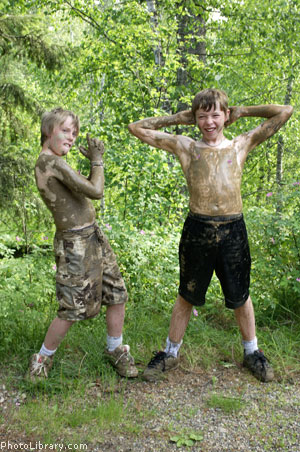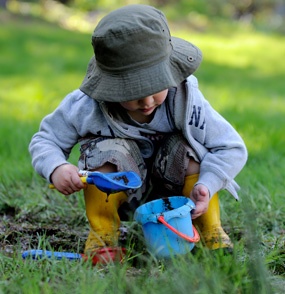We have much more to do and your continued support is needed now more than ever.
This Earth Day, Get Earthy with Three Fun Dirt Activities
Guest post by Rhonda Lucas Donald
 Much to some parents’ chagrin, little kids love to dig in the dirt, muck about in the mud, and roll in the grass. This Earth Day, turn their soil shenanigans into artistic statements that celebrate our planet—and the all-important soil that covers it.
Much to some parents’ chagrin, little kids love to dig in the dirt, muck about in the mud, and roll in the grass. This Earth Day, turn their soil shenanigans into artistic statements that celebrate our planet—and the all-important soil that covers it.
Mud is the Medium: Make Dirt Shirts
To you, mud stains may be a laundry challenge. But to the Senufo people of Africa’s Ivory Coast, mud is the stuff of art. They use mud to paint intricate designs on cloth, which they wear or sell.
Your kids can make mud the medium for Earth Day designs on a T-shirt or tote bag. Have your kids dress in clothes that you won’t mind getting dirty—because they will!
What you need:
- Bowl
- Spoon
- Water
- Newspaper or paper towels
- Permanent marker
- White T-shirt or whatever you want to decorate
- Dirt!
What you do:
1. If painting a shirt or tote bag, put several layers of newspaper or paper towels inside it to keep the mud from soaking through to the back of the shirt.
2. Add a few handfuls of dirt to the bowl and pick out any rocks, leaves, twigs, or other debris.
3. Add water and stir to make mud the consistency of tempera paint. If your mud isn’t dark enough, you can add a bit of black or brown water-based paint to it.
4. Your child can use fingers or sticks to apply the paint. You can also coat items such as leaves, grass, or hands with mud and use them to make prints on the shirt.
5. Encourage your child to think up an Earth Day slogan. “I Dig the Earth!” and “Dirt Shirt for the Earth” are a couple of ideas. Write the slogan in mud or use a permanent marker.
6. Let the painting dry and shake off any caked-on mud before proudly wearing the dirt shirt. The design will fade in the wash, but your child can always reapply!
Soil Celebrations
 If your kids have grown beyond mud messes, they can show their earthy appreciation by starting a compost pile. But first, take a look at what puts the “earth” in Earth Day: soil.
If your kids have grown beyond mud messes, they can show their earthy appreciation by starting a compost pile. But first, take a look at what puts the “earth” in Earth Day: soil.
Scoop up some soil and spread it out on a piece of paper. Use a magnifying glass to examine the fine particles that make it up. You should see tiny pieces of rock and sand, as well as bits of leaves, twigs, and plant roots. Other important soil ingredients are water and air.
Explain that soil is alive: It contains millions of bacteria, as well as worms, insects, and other creatures that live in soil and help keep it fertile and aerated.
The organic part of soil is called humus. Humus holds nutrients and helps soil retain moisture. The humus in your compost will enhance the soil in your yard, garden, and flowerpots. Composting is easy to do.
How to Make a Compost Pile
1. Make a pile of dry leaves, grass clippings, and light brush. Your pile can be right on the ground. Add fruit and vegetable peelings, coffee grounds, even shredded paper.
2. Do not add meat or fatty or greasy foods. Do not add manure from pets that eat meat, such as dogs and cats. It’s OK to add droppings from guinea pigs, hamsters, mice, and other plant-eating pets. Also leave out any weeds, because they may contain seeds that may germinate when you add the compost to your garden. Rule of thumb: Don’t compost any plant part that you don’t want to see again.
3. Use a rake or shovel to turn the compost every now and then. The more you turn it, the quicker it will decompose.
4. It will take several months for the pile to break down using this method, known as cold composting. If you’d like to speed things up, try hot composting or composting with worms. Visit the U.S. Department of Agriculture’s site for more information on backyard composting.
A Little Dirt Won’t Hurt
In case you’re worried about exposing your child to undesirable microbes in dirt, fear not. Although there are millions of bacteria in dirt—and on and in our bodies too—most are harmless and many are beneficial. Studies indicate that exposure to germs in childhood helps build a healthy immune system. Living in an ultra-sanitized environment may actually lead to conditions such as allergies and asthma. Turns out that being earthy is also healthy!
Mud pies, anyone? Click here for more dirt activities!
Stuck indoors? Have your kids visit Amtrak’s KidsDepot. Click on “Parks” or “Playground” and find fun online games that teach about nature and the outdoors.
Rhonda Lucas Donald is an award-winning freelance writer living in Petersburg, Va. She has contributed stories, crafts, and poems to Ranger Rick and Your Big Backyard magazines and is the author of more than 12 books for children and teachers. Look for her latest picture book, Deep in the Desert, in spring 2011, and visit her website at www.browntabby.com





















